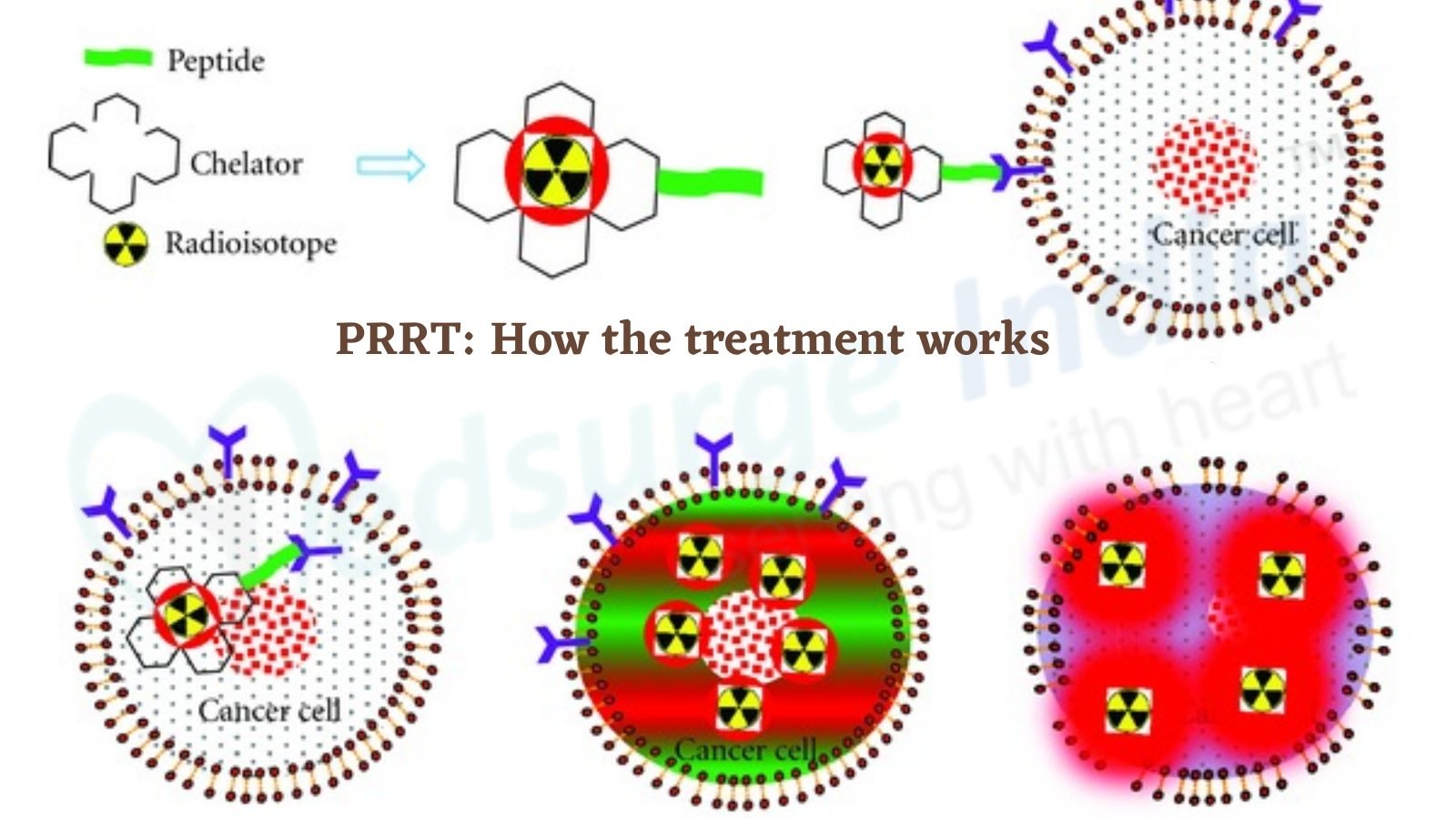
What is PRRT?
Peptide Receptor Radionuclide Therapy (PRRT) is a type of molecular targeted therapy in which a tiny peptide is combined with a radionuclide that emits beta radiation. PRRT Treatment is a new nuclear medicine technique for the systemic treatment of neuroendocrine tumors that have spread.
Gastroenteropancreatic tumors can arise from the small bowel (also known as carcinoid tumors), the pancreas, the duodenum, or the stomach, as well as the large bowel, the lung, and a variety of other organs (so-called diffuse neuroendocrine system).
Only individuals with somatostatin receptor-positive tumors can get this type of molecular radiation therapy. Many neuroendocrine tumors, although not all, express one or more somatostatin receptor subtypes.
This means that when specific somatostatin analogue medications (most commonly octreotide) come into touch with tumors, the drug is absorbed by the receptors. The tumor absorbs both the chemical and the radiation when the medication (a short peptide of 8 amino acids) is chemically bonded to a type of radiation (the radionuclide).
The tumors will be killed by the beta particles that are emitted. Lutetium-177 and Yttrium-90 are the most effective radionuclides currently in use.
How does PRRT Treatment Work?
Consider the analogy of a magnet and its ability to attract iron shavings to understand the workings of PRRT. Consider a somatostatin-positive neuroendocrine tumor as the magnet, and the iron shavings as a somatostatin analogue chemical (Octreotide) bound or connected to some radioactive substance (the radionuclide Y90 or LU177).
The octreotide is attracted to the receptors in tumors, and this chemical, along with the radioactive material, is absorbed into the tumor by the receptor. The tumor cells are then killed by the radiation.
As a result, PRRT Treatment is a type of targeted therapy that can affect cancers that can absorb particular compounds attached to radioactive elements. This type of therapy is systemic since the octreotide with the radionuclide is injected into the patient’s bloodstream, reaching all regions of the body.
Who should consider PRRT Treatment?
PRRT (Peptide Receptor Radionuclide Therapy) is not effective against all neuroendocrine tumors. You must have somatostatin receptors in your tumors for this treatment to work. When a somatostatin analogue (such as a variant of octreotide) is coupled with a radionuclide like Lutetium-177 (LU177) or Yttrium-90 (Y90), it exhibits a high affinity for the somatostatin receptor subtype-2 found in NET tumors. This means that the radioactive material injected into the body for treatment will be immediately absorbed by the tumor, causing it to die.
PRRT is a systemic treatment that affects neuroendocrine tumors with receptors throughout the body. This type of treatment is typically used for patients who have several non-resectable tumors. This therapy is used on some individuals who only have tumors in the liver to diminish the size and quantity of tumors in the liver or other bodily locations in preparation for surgery.
Many factors must be considered before opting to pursue this method of treatment, in addition to the presence of somatostatin receptors in a patient’s tumors. Tumor load, in terms of size, quantity, and location, is unquestionably important. Age and physical condition could also be factors.
Outcomes of PRRT
Typically, most cancer patients wish to learn about the survival statistics for their specific type of cancer. Any report on the efficacy of treatment nearly often includes the survival rate and other indicators in months or years. There are various markers of therapeutic efficacy that are significant when evaluating a treatment for people with NET cancer.
When you and your doctor are deciding which treatment option is best for you, make sure to compare PRRT’s Time to Progression/Progression-Free Survival and Duration of Therapy Response to other options.
In overall survival, this is another time-based metric that begins from the time of diagnosis and continues until death. In the majority of cases, this measurement refers to a specific form of cancer. It is also used to determine how long a patient will live after receiving a certain type of treatment.
What are the Risk and Side-Effects of PRRT?
What are the Risks?
There are dangers involved with using PRRT to treat metastasized tumors, as there are with most, if not all, of the therapeutic choices available to neuroendocrine tumor patients. Radiation toxicity has the biggest risk because it affects three things:
1) The blood system, which produces Red Blood Cells, White Blood Cells, and Blood Platelets,
2) The kidneys, and
3) liver functioning
Kidney impairment or renal insufficiency was once a substantial danger, but as procedures for protecting the kidney during PRRT become more developed, the risk has decreased significantly. All medical centers that provide PRRT now take very careful precautions to preserve the kidneys by infusing amino acids before and after the procedure.
While no specific preventative strategies for the liver or the blood system have been devised. Radiation toxicity is reduced when the dose of radiation is well controlled.
What are the Side Effects?
Although each patient’s reaction to PRRT Treatment is unique, there are some side effects that are more prevalent and others that are less common among patients. These side effects can last anywhere from a few hours to many days.
Patients receiving PRRT should usually have some nausea and pain drugs on hand to use on the return trip to their home. If a patient experiences nausea, vomiting, or pain during the PRRT, medicine is usually given to them right away.
The following are the most common side effects:
- Nausea and vomiting
- Discomfort or pain in the abdomen
The following are some of the less common side effects:
- Hematological toxicity (subacute)
- Hair loss that is only temporary
Renal insufficiency occurs in some situations due to delayed toxicity to the kidneys.
- Hematologic poisoning is rare
As a result, as compared to chemotherapy, PRRT Treatment often has fewer adverse effects. PRRT is a highly successful therapy option for managing advanced, progressing neuroendocrine tumors. PRRT isn’t a cure, but it has been demonstrated to help reduce symptoms and halt the disease’s course.
Conclusion
The overall response rate (including complete response, partial response, minor response, and stable disease) for the two most commonly used radiopharmaceuticals: yttrium-90 (90Y)-DOTATOC (best suited for treating larger tumors) and yttrium-90 (90Y)-DOTATOC (best suited for treating smaller tumors) is about 70-80%.


